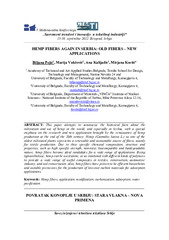Приказ основних података о документу
HEMP FIBERS AGAIN IN SERBIA: OLD FIBERS – NEW APPLICATIONS
| dc.creator | Pejić, Biljana | |
| dc.creator | Vukčević, Marija | |
| dc.creator | Kalijadis, Ana | |
| dc.creator | Kostić, Mirjana | |
| dc.date.accessioned | 2023-03-15T14:51:23Z | |
| dc.date.available | 2023-03-15T14:51:23Z | |
| dc.date.issued | 2022 | |
| dc.identifier.isbn | 978-86-900426-4-7 | |
| dc.identifier.uri | http://TechnoRep.tmf.bg.ac.rs/handle/123456789/6085 | |
| dc.description.abstract | This paper attempts to summarize the historical facts about the cultivation and use of hemp in the world, and especially in Serbia, with a special emphasis on the research and new application brought by the renaissance of hemp production at the end of the 20th century. Hemp (Cannabis Sativa L.) as one of the oldest cultivated plants represents a renewable and sustainable source of fibers, mainly for textile production. Due to their specific chemical composition, structure and properties, such as high specific strength, non-toxic, biocompatible and biodegradable nature, hemp fibers become ideal candidates for a wide range of applications. Being lignocellulosic, hemp can be used alone, or as combined with different kinds of polymers to provide a wide range of useful composites in textiles, construction, automotive industry, and soil conservation. Also, hemp fibers have proven to be efficient biosorbents and suitable precursors for the production of low-cost carbon materials for adsorption applications. | sr |
| dc.description.abstract | U ovom radu su sumirane istorijske činjenice o gajenju i upotrebi konoplje u Srbiji i svetu, sa posebnim osvrtom na istraživanja i nove primene sa renesansom konoplje krajem 20. veka. Konoplja (Canabis Sativa L) je jedna od najstarijih gajenih biljaka, i predstavlja obnovljiv i održiv izvor vlakana, uglavnom za tekstilnu industriju. Zbog svog specifičnog hemijskog sastava, strukture i svojstava, kao što su visoka specifična čvrstoća, netoksičnost, biokompatibilnost i biorazgradivost, vlakna konoplje imaju visok potencijal za primenu u različitim oblastima. Sama, ili kao kompozit u kombinaciji sa različitim vrstama polimera, konoplja nalazi primenu u oblastima tekstila, građevinarstva, automobilske industrije, očuvanja životne sredine. Takođe, vlakna konoplje su se pokazala kao efikasni biosorbenti i pogodni prekursori za proizvodnju jeftinih ugljeničnih adsorbenata za prečišćavanje vode od organskih i neorganskih zagađujućih materija. | sr |
| dc.language.iso | en | sr |
| dc.publisher | Union of engineers and textile tehnicians of Serbia, Belgrade, Serbia, | sr |
| dc.rights | openAccess | sr |
| dc.rights.uri | https://creativecommons.org/licenses/by/4.0/ | |
| dc.source | V Međunarodna konferencija „Savremeni trendovi i inovacije u tekstilnoj industriji“ | sr |
| dc.subject | Hemp fibers | sr |
| dc.subject | application | sr |
| dc.subject | modification | sr |
| dc.subject | carbonization | sr |
| dc.subject | adsorption | sr |
| dc.subject | water purification | sr |
| dc.subject | Vlakna konoplje | sr |
| dc.subject | primena | sr |
| dc.subject | modifikacija | sr |
| dc.subject | karbonizacija | sr |
| dc.subject | adsorpcija | sr |
| dc.subject | prečišćavanje vode | sr |
| dc.title | HEMP FIBERS AGAIN IN SERBIA: OLD FIBERS – NEW APPLICATIONS | sr |
| dc.type | conferenceObject | sr |
| dc.rights.license | BY | sr |
| dc.citation.epage | 12 | |
| dc.citation.spage | 3 | |
| dc.identifier.fulltext | http://TechnoRep.tmf.bg.ac.rs/bitstream/id/16140/bitstream_16140.pdf | |
| dc.identifier.rcub | https://hdl.handle.net/21.15107/rcub_technorep_6085 | |
| dc.type.version | publishedVersion | sr |

